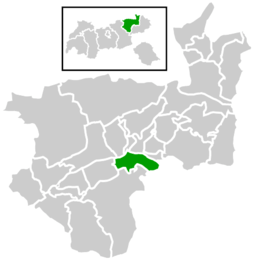Wörgl
| Wörgl | ||
|---|---|---|
| ||
 Wörgl | ||
Location within Kufstein district
| ||
| Coordinates: 47°29′N 12°04′E / 47.483°N 12.067°ECoordinates: 47°29′N 12°04′E / 47.483°N 12.067°E | ||
| Country | Austria | |
| State | Tyrol | |
| District | Kufstein | |
| Government | ||
| • Mayor | Hedi Wechner (SPÖ) | |
| Area | ||
| • Total | 19.68 km2 (7.60 sq mi) | |
| Elevation | 511 m (1,677 ft) | |
| Population (1 January 2013)[1] | ||
| • Total | 12,723 | |
| • Density | 650/km2 (1,700/sq mi) | |
| Time zone | CET (UTC+1) | |
| • Summer (DST) | CEST (UTC+2) | |
| Postal codes | 6300-6302 | |
| Area codes | 043-5332 | |
| Vehicle registration | KU | |
| Website | www.woergl.at | |
Wörgl is a town in the Austrian state of Tyrol, in the Kufstein district. It is 20 km from the state border with Bavaria.
Population
| Historical population | ||
|---|---|---|
| Year | Pop. | ±% |
| 1869 | 1,080 | — |
| 1880 | 1,485 | +37.5% |
| 1890 | 2,319 | +56.2% |
| 1900 | 3,126 | +34.8% |
| 1910 | 4,232 | +35.4% |
| 1923 | 4,155 | −1.8% |
| 1934 | 4,196 | +1.0% |
| 1939 | 4,689 | +11.7% |
| 1951 | 6,247 | +33.2% |
| 1961 | 6,828 | +9.3% |
| 1971 | 7,937 | +16.2% |
| 1981 | 8,598 | +8.3% |
| 1991 | 10,041 | +16.8% |
| 2001 | 10,885 | +8.4% |
| 2011 | 12,645 | +16.2% |
Transport
Wörgl is an important railway junction between the line from Innsbruck to Munich, and the inner-Austrian line to Salzburg. Its railway station has been designated as a Hauptbahnhof (German: main station) since 10 December 2006.
European route E641 connects Wörgl with Salzburg, the routes E45 and E60 (Austrian autobahn A12) pass through Wörgl.
-

Wörgl railway station in 1900
-

Wörgl railway station in 1965
Twin cities
-
 Albrechtice nad Orlicí, a small village of just over 1,000 inhabitants in the Czech Republic.
Albrechtice nad Orlicí, a small village of just over 1,000 inhabitants in the Czech Republic. -
 Suwa, Nagano, Japan
Suwa, Nagano, Japan
The Wörgl Experiment

Wörgl was the site of the "Miracle of Wörgl" during the Great Depression. It was started on July 31, 1932, with the issuing of "Certified Compensation Bills", a form of currency commonly known as Stamp Scrip, or Freigeld. This was an application of the monetary theories of the economist Silvio Gesell by the town's then-mayor, Michael Unterguggenberger.
The experiment resulted in a growth in employment and meant that local government projects such as new houses, a reservoir, a ski jump and a bridge could all be completed, seeming to defy the depression in the rest of the country. Inflation and deflation are also reputed to have been non-existent for the duration of the experiment.[citation needed]
Despite attracting great interest at the time, including from French Premier Edouard Daladier and the economist Irving Fisher,[2] the "experiment" was terminated by the Austrian National Bank on the September 1, 1933.[3][4]
In 2006 milestones were placed, beginning from the railroad station through the downtown, to show this history.[5]
Notable personalities
- Reinhard Furrer, a German scientist and astronaut, was born in Wörgl.
- Gerhard Berger, a former Formula One driver and former co-owner of Scuderia Toro Rosso, was born in Wörgl.
- Stefan Horngacher, an Olympic ski jumper, was born in Wörgl.
- Hans Hömberg, a German film-director, dramatist and author, lived in Wörgl in his later years.
- Heinz Zak, an extreme climber and photographer, was born in Wörgl.
- Hans Peter Haselsteiner, a building tycoon and former deputy chair of the Liberal Forum, was born in Wörgl.
Gallery


See also
References
- ↑ Statistik Austria - Bevölkerung zu Jahres- und Quartalsanfang, 2013-01-01.
- ↑ http://www.cato.org/pubs/journal/cj10n3/cj10n3-13.pdf
- ↑ David Boyle, The Money Changers - Currency Reform from Aristotle to e-cash, Earthscan, 2002, ISBN 1-85383-895-0, p.237.
- ↑ Eric Helleiner, The Making of National Money - Territorial Currencies in Historical Perspective, Cornell University Press, 2003, ISBN 0-8014-4049-1, p.158-9.
- ↑ http://meilensteine.woergl.at/
External links
| Wikimedia Commons has media related to Wörgl. |
- Municipal data for Wörgl. In: Statistik Austria.
- Wörgl's attempt in the 1930s to establish a local currency
- Wörgl Gigapixel Panorama (11.000 Megapixel)
- Community Currency Online Magazine
- Website of the Wörgl Tourist Board
| |||||

